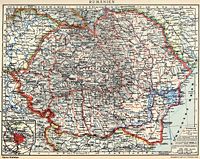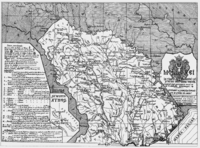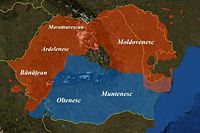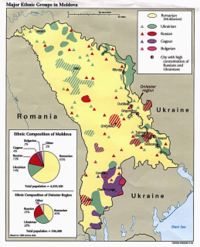Moldovans
2008/9 Schools Wikipedia Selection. Related subjects: Peoples
| Moldovans Moldoveni |
|---|
| Total population |
|
3.2-3.5 million |
| Regions with significant populations |
| Moldova: 2,741,849 (2004) ( Transnistria included) Ukraine (2001): |
| Languages |
| Moldovan/ Romanian |
| Religion |
| Predominantly Eastern Orthodox. |
| Related ethnic groups |
|
• Vlachs |
Moldovans, or Moldavians (original name: Moldoveni; Молдовень in the Moldovan Cyrillic script, used nowadays only in Transnistria) are the native population in, depending on one's interpretation, all or part of the lands that correspond to the former Principality of Moldavia. The first chronicle Descriptio Moldaviae attesting of Moldavians dates back to the beginning of the 18th century, which itself describes Moldavians as of the XIVth century. In the Republic of Moldova, the term Moldovans is used to officially denote an ethnicity separate from Romanians.
The notion of Moldovans as a separate ethnicity, distinct from Romanians, is controversial. Among self-declared Moldovans, more than 80% consider themselves as different from Romanians. Outside of the Moldovan Republic, this group is currently recognized as a minority ethnic group only in several former Soviet republics.
Population
Moldovans constitute 76.1% of the population of Moldova. In the breakaway region of Transnistria, in the eastern part of the country, they compose a plurality with 31.9% of the population.
The 2001 census in Ukraine counted 258,600 Moldovans. They live mostly in the Budjak region or south-west Odessa Oblast and the Novoselytskyi Raion, but also in other areas of Odessa Oblast, bordering the Republic of Moldova.
In Romania, some six or seven million people consider themselves to be “Moldovans” as an integral part of, not distinct from, the Romanian nation . In 2007 a number of Romanian citizens have attempted to seek official recognition of the minority status for the Moldovans in Romania. Around the same time, during a visit of three delegates of this movement in Moldova, Moldovan President Vladimir Voronin spoke of 10 million Moldovans living in the neighbouring country, though this number may be exaggerated. People who declared themselves Moldovans in the last Romanian census were reported as Romanians in the census results.
History

Until the 1920s, specialists generally considered the Moldovans a subgroup or regional group of the Romanian ethnos. After 1924, Soviet authorities began to emphasize a distinct Moldovan language, history and culture, and to support the claim that Moldovans constitute a separate ethnic group. Soviet policy on the Moldovan language was not constant: there were two intervals (1932-1937 and in the mid-1950s) during which the Soviet scholars declared the unity between the two languages.
Numerous Romanians, as well as a part of the Moldovan population, claim that external interference rather than any actual differences led to Moldova's increasingly separate identity. Despite this, Moldovans have pressed for recognition of an ethnic Moldovan identity, separate from that of Romanians. In the 2004 census, out of the 3,383,332 people living in Moldova, 16.5% (558,508) chose Romanian as their mother tongue, whereas 60% chose Moldovan. While 37% of all urban Romanian/Moldovan speakers chose Romanian as their mother tongue, in the countryside this percentage was just under 15.
Religion
The major denomination in both Moldova and Romania is Eastern Orthodox Christianity. The difference between Moldova and Romania is the acceptance of different bishops authority (see Eastern Orthodox Church organization), expressed as affiliation to distinct autocefalous churches (respectively Russian and Romanian) within the Eastern Orthodox communion. Basically, in Moldova there is an ongoing politically charged bishop territorial jurisdiction and administrative succesional issue which, from an ecclesiastical point of view, is subject to canon laws (not a faith related, theological, or denominational difference). Thus, most Eastern Orthodox in Moldova belong to the autonomous Moldovan Orthodox Church, which depends on the Russian Orthodox Church. Immediately after Moldova declared independence from the Soviet Union (1991), the Romanian Orthodox Church reactivated a previous structure, forming the autonomous Metropolis of Bessarabia (1992), which was only officially recognized in 2002. The dispute's subject is the succession of the pre-WWII Metropolitan See of Bessarabia, the Supreme Court of Moldova ruling in favour of the Moldovan Orthodox Church, while the European Court of Human Rights in favour of the Metropolis of Bessarabia. It is also an open issue between the Russian and Romanian Orthodox Churches. As of 2007, the Moldovan Orthodox Church has 1255 parishes, while the Metropolis of Bessarabia has 219.
Moldovan ethnos theory and the Romanian identity
Moldovan ethnos theory
In the past, the term Moldavian/Moldovan has been used to refer to the population of the historical Principality of Moldavia. Nevertheless, after 1924, Soviet sociologists began using the term to demonstrate the distinctiveness of the natives of Bessarabia, in a movement called Moldovenism. On December 19, 2003, the Moldovan Parliament adopted "The Concept on National Policy of the Republic of Moldova" which critics have accused is a revival of the Soviet-style Moldovenist theories. The document states that Moldovans and Romanians are two distinct peoples that speak two similar languages, Romanians form an ethnic minority in Moldova, and that the Republic of Moldova is the legitimate successor to the Principality.
Today, Moldovans are recognized as an ethnic group by several ex-Soviet countries. Presently, the largest number of people who declared their ethnicity as Moldovan live in the Republic of Moldova, where according to the 2004 Census, they comprise 76.1% of the population. In Ukraine, according to that country's census in 2001, Moldovans constitute a recognized ethnic minority of 0.53% (7.28% in Chernivtsi Oblast and 5.01% in Odessa Oblast).
Romanian identity
On the other side of the debate, the arguments go that the self-designation of Romanians living in Transilvania, Wallachia and the Principality of Moldova as Romans is mentioned in scholarly works as early as the 16th century, such as works of Italian humanists traveling to those lands. Thus, Tranquillo Andronico writes in 1534 that Vlachs "now call themselves Romans". In 1532, Francesco della Valle accompanying Governor Aloisio Gritti to Transylvania, Wallachia and Moldavia notes that Romanians preserved the name of the Romans (Romani) and "they call themselves in their language Romei". Ferrante Capeci writes around 1575 that the inhabitants of these countries call themselves “Romanesci”, Other evidence about the name "Romanians" comes from authors having lived in the these principalities, such as Anton Verancsics, who writes around 1570 that Romanians living in Transylvania, Moldavia and Wallachia call themselves "Romans"
As the appellative "Romanian" was gaining more and more popularity throughout the western Ottoman-dominated Moldavia during the 19th century, its introduction in Bessarabia, a province of the Russian Empire at the time, was welcomed mostly by the Romanian-oriented elite, while the majority of local population continued to use the old ethnonym "Moldavians".
Modern controversy
In Romania, there was no Moldovan ethnicity reported in the 2002 census, and people whose self-identification is considered regional by the Romanian government having been counted as Romanians. In the CIA World Factbook a single entry "Moldovan/Romanian" is used. A group of international census experts observing the census had stated that "the census had been generally conducted in a professional manner", however, they also identified certain problems in the collection of data for this census, among others in the domain of nationality and language. Experts have noted that large part of the population has responded spontaneously, however they have reported some cases when the census enumerators have encouraged respondents to declare that they were "Moldovans" rather than "Romanians". According to BBC, European observers that monitored the 2004 Moldovan census contested the data about the spoken language and the ethnic affiliation in reference to Moldovan-Romanian debate, noting that these data can not be considered as expressing the truth.


